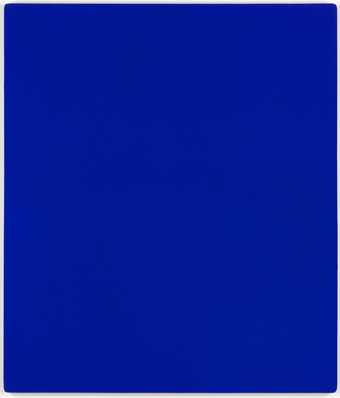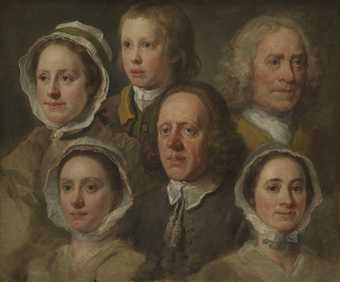Heimo Zobernig on Henry Wallis’s The Room in Which Shakespeare Was Born 1853
Looking for the void – for what’s not there. Nothing found. I drew a blank. A monochrome painting in golden ochre. I don’t know the original painting, just the little digital image. Maybe it’s the title that largely accounts for the fact that this picture has stayed with me. It refers to an event that is not shown in the picture. There is no bed or any item of furniture where a child could be born. In fact, there is nothing in the centre of the room. And the centre of the painting is not only optically empty, creating a real spatial void, it’s also empty as far as time is concerned. Is the empty space intended for what is to come, or is it an echo of what has already been?

Henry Wallis
The Room in Which Shakespeare Was Born (1853)
Tate
One’s gaze is drawn to the centrally placed window, which conveys only a diffuse glimpse of the outside world. The geometry of the room has been idealised; from the viewer’s standpoint, this view could only be achieved using a wide-angle lens. Seven chairs and two writing desks have been pushed up against the walls, so that the furniture, far from shaping the space, accentuates the void in the centre. This arrangement does not suggest any meaningful use of these items by the room’s fictive inhabitant. Despite the highly detailed, painterly description of the various objects and the planes defining the space, they merely provide a backdrop for what is missing in the middle of the room.
Was this the inspiration for a monochrome painting in golden ochre, such as the one by Olivier Mosset that I recently saw at the Whitney Biennial in New York, or for images of non-existent centres, in the shape of holes, as in the sculptures of Barbara Hepworth?
Much ado about nothing.
— The Room in Which Shakespeare Was Born was purchased in 1955.
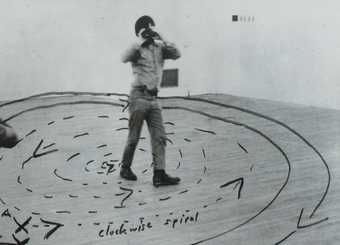
Dan Graham
Two Correlated Rotations 1970–2
Detail of an annotated photograph of a performance
Photo: Marcus Leith and Andrew Dunkley
Courtesy the artist and Lisson Gallery © Dan Graham
Tim Lee on Dan Graham’s Two Correlated Rotations 1970–2
What happens when one loophole leads to another? Among other things, most of all I’m indecisive. This, of course, has the dangerous potential to be paralysing. None the less, when I’m sometimes trapped in my idle thinking I somehow feel productive, simply because it seems that I’m trying to think things through. Also – and this is perfectly commensurate with my wayward resolve – I’m restless. Once I’ve meandered my way towards a resolution, I almost immediately find myself wanting to move on. And so it goes: the slow move towards realising an eventual position inevitably shifts to another (and so on and so forth).
Dan Graham’s Two Correlated Rotations illustrates a similar irresoluteness. When I think of my own restless, back-and-forth nature, I think of Graham’s cinematic experiment. And when I think of the dual projections of two cameramen filming each other while walking in counter-spirals into and away from the opposite’s point of view, I think of the way in which its divergent, wandering and erratic sense of perspective might offer itself as not just a simple formal exercise, but as a strange model of liberated reasoning. If dissonance is a phenomenon that cuts across all formal, sensory and emotional divides, then Two Correlated Rotations allows one to exploit its discordant effects for the purposes of unconventional thought – rationality can take one only so far.
And yet what if irrationality itself becomes the operative standard? If Graham’s model of upended geometry and multiple perspectives asserts itself as the potential new norm, the effect of all positions never achieving full autonomy can be just as equally disorientating, discomforting and disastrous. Indeed, there’s nothing more spectacular than a disaster, and in an ongoing loop of perspectives that spiral out to form a continuum of perpetual digressions, it may be that this new tangled logic can yield only greater confusion.
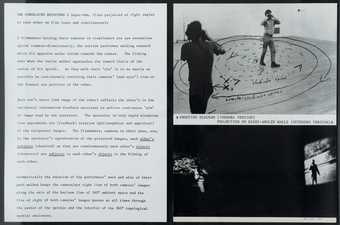
Dan Graham
Two Correlated Rotations 1970–2
Details and photographs of a performance
Photo: Marcus Leith and Andrew Dunkley
Courtesy the artist and Lisson Gallery © Dan Graham
— Two Correlated Rotations was purchased in 1973 and is on display, for the first time, on level 5 at Tate Modern.
David Shrigley on William Hogarth’s Gin Lane 1751
William Hogarth’s Gin Lane is part of a diptych. It warns of the perils of drinking gin as opposed to the supposed merits of drinking beer, as depicted in Beer Street, the other half of the diptych. Gin Lane depicts a society in chaos with scenes of infanticide, starvation, madness, decay, cruelty, suicide and death. As opposed to Beer Street, where everything is fine apart from most people being very fat.
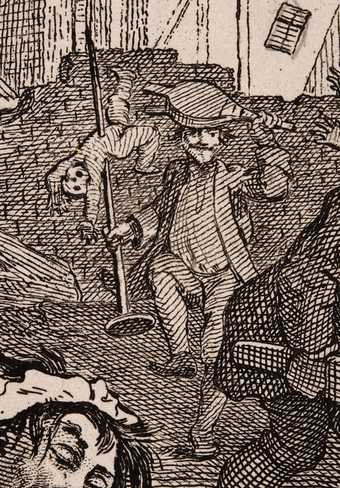
William Hogarth
Detail, Gin Lane 1751
Print
35.7 x 30.5 cm
Photo: Tate
The character that interests me the most in Gin Lane is the fellow who appears to be dancing a jig while striking himself on the head with a pair of bellows and holding a spike in his other hand with a baby impaled on it. We presume the woman trying to intervene might be the baby’s mother.
Gin Lane is reminiscent of Glasgow city centre on a weekend evening. Everyone is drunk apart from the emergency services and American tourists, who probably wish they were. There are parts of Glasgow city centre where everybody is drunk all of the time. My studio is located in one such part of town. There is a high metal fence with barbed wire at the back of my building, where I greet art transporters and the like through a gate with a giant padlock on it. We never leave the gate open in case the Gin Lane folk get it. It’s a bit like being one of the characters under siege from the zombies in a George A. Romero film.
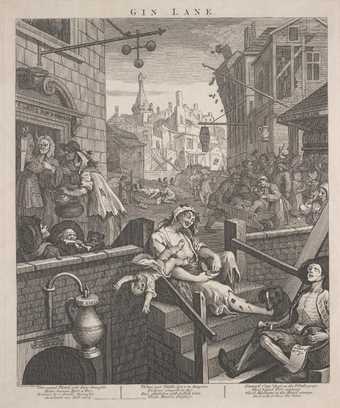
William Hogarth
Gin Lane (1751)
Tate
Kay Rosen on Yves Klein’s IKB 79 1959
My Blue Heaven, Wild Blue Yonder, Blue Skies, blue screen … … … out of the blue … . . Blue Angels, Blue Moon, bleu cheese, blue planet … … … … … … … … Blue Ridge Mountains, bluegrass, Babe the Blue Ox, Blueberry Hill, Hill Street Blues, NYPD Blue, Blue Meanies … … … . black and blue, between the devil and the deep blue sea … … … … … … … … . . Blue Bayou, Blue Point Oysters, Great Blue Heron, blue jay, Bluebird of Happiness, When Sunny Turns Blue, Blue Eyes Crying in the Rain, Love Is Blue, Blue Monday… . . Blues For Mister Charlie, House of Blue Leaves … … … bluebonnets, Red Roses for a Blue Lady, Bluebeard, Ol’ Blue Eyes, Blues Brothers, Blues Magoos, Blue Guitar, Blue Period … . . Der Blaue Reiter, Bonnie Blue Butler, Little Boy Blue, The Blue Boy, Blue Velvet, Alice Blue Gown … … … . . blue ribbon, Pabst Blue Ribbon … … Blue Plate Special, blue jeans, blue collar, Blue Suede Shoes … … … … … . . Rhapsody in Blue, Birth of the Blues, Blusette, Blue Rondo à la Turk, Señor Blues, All Blues, true blue, Kind of Blue, Almost Blue, Blue Note … … … … . . Blue Movie, Blue, Biloxi Blues… … … … … . Rhythm and Blues, talking a blue streak, talking till blue in the face …
— IKB 79 was purchased in 1972 and is on display at Tate Liverpool

